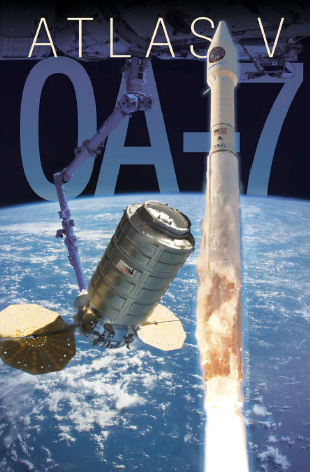

Positive information comes from ULA indicating that everything is progressing toward the ULA Atlas V launch carrying the OA-7 Cygnus spacecraft for Orbital ATK and NASA.
The mission is set to lift off on a ULA Atlas V rocket on Tuesday, April 18 from Space Launch Complex-41 at Cape Canaveral Air Force Station in Florida. Today’s L-2 forecast shows a 90 percent chance of favorable weather conditions for launch. The April 18 launch window is 11:11-11:41 a.m. EDT. Live programming will begin at 10 a.m. EDT; webcast available here.
Launch Forecast Summary:
- Overall probability of violating weather constraints: 10 percent
- Primary concerns: Cumulus Clouds
- Overall probability of violating weather constraints for 24 hour delay: 20 percent
- Primary concern: Cumulus Clouds and Thick Clouds
A United Launch Alliance (ULA) Atlas V 401 rocket will launch the Cygnus™ spacecraft on the initial leg of its cargo resupply mission to the International Space Station (ISS). Liftoff will occur from Space Launch Complex-41 at Cape Canaveral Air Force Station, Florida.
Orbital ATK developed the Cygnus advanced maneuvering spacecraft to perform ISS cargo delivery missions under the Commercial Resupply Service (CRS) contract with NASA. At a total weight of approximately 7,225 kg (15,928 lb), OA-7 will include approximately 3,380 kg (7,452 lb) of internal cargo and an 83 kg (183 lb) external deployer carrying CubeSats.
Cygnus is a low-risk design incorporating elements drawn from Orbital ATK and its partners’ existing, flight-proven spacecraft technologies. Cygnus consists of a common Service Module (SM) and a Pressurized Cargo Module (PCM). The SM is assembled and tested at Orbital ATK’s Dulles, Virginia, satellite manufacturing facility and incorporates systems from Orbital ATK’s flight-proven LEOStar™ and GEOStar™ satellite product lines. The PCM is based on the Multi-Purpose Logistics Module, developed and built by Thales Alenia Space of Italy.
The OA-7 mission is the seventh Cygnus flight, and third Cygnus flight onboard an Atlas V rocket, following the extremely successful OA-4 and OA-6 launches in December 2015 and March 2016, respectively. The Cygnus spacecraft for the OA-7 mission will fly the Saffire-III experiment, developed and built by NASA’s Glenn Research Center, that tests properties of combustion in microgravity, as well as an external deployer carrying CubeSats that will be deployed after separation from the ISS. It is the fourth flight of Orbital ATK’s enhanced Cygnus featuring a larger PCM with increased cargo capacity and an optimized SM design including Orbital ATK’s lightweight UltraFlex™ solar arrays.
Mission Description: Orbital ATK developed the Cygnus advanced maneuvering spacecraft to perform ISS cargo delivery missions under the Commercial Resupply Service (CRS) contract with NASA. At a total weight of approximately 7,225 kg (15,928 lb), OA-7 will include approximately 3,380 kg (7,452 lb) of internal cargo and an 83 kg (183 lb) external deployer carrying CubeSats.

